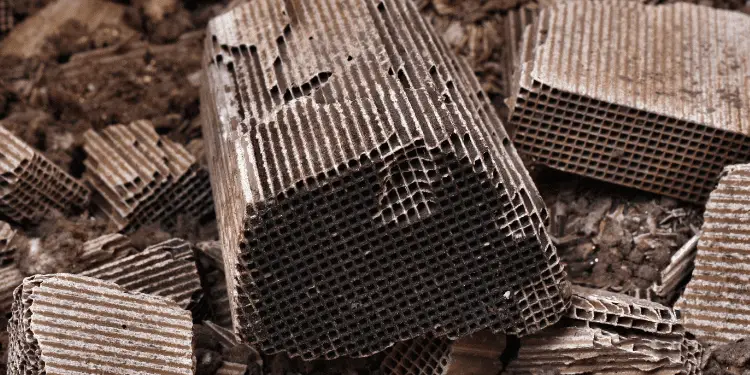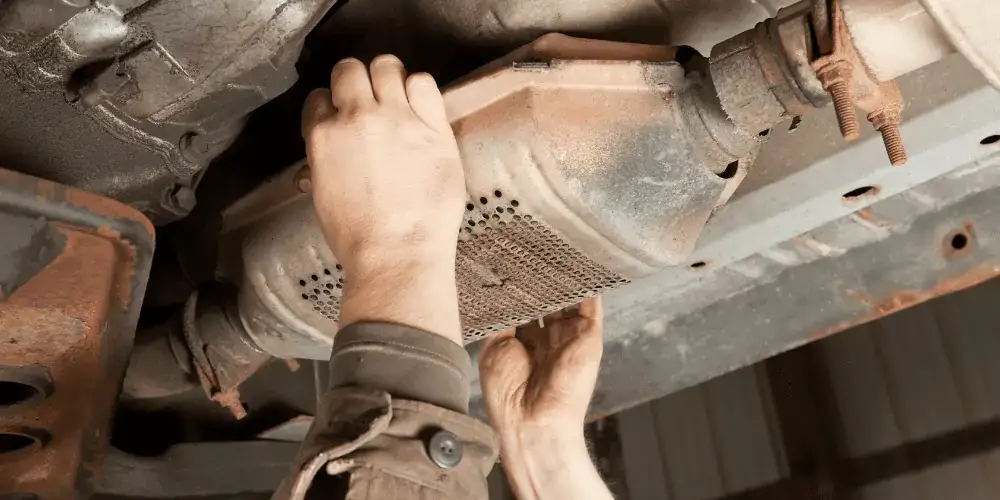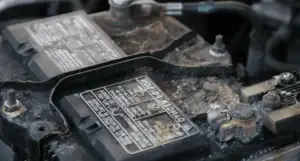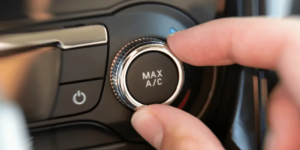A catalytic converter does smell, but why and what is the smell like? It’s the exhaust gases leaving the tailpipe of the car. Usually, the exhaust entering the catalytic converter gets converted to almost odorless gas. When that process doesn’t happen fully, you’re left with a strong rotten egg odor wafting into your nostrils.
Some people describe it as eggy sulfur or a burning match smell. When driving, your car’s engine burns gasoline, producing carbon dioxide (CO2) and water vapor. CO2 and water vapor go into a catalytic converter, which reacts with oxygen to produce carbonic acid and water as byproducts.
The reaction also creates enough heat to boil off some of the water vapor from inside the catalytic converter. That boiled-off water vapor is what we smell when we drive our cars!
What does a catalytic converter do?
A catalytic converter is a device that reduces the number of pollutants in the exhaust of your vehicle. It does this by using a chemical reaction between the exhaust gases and a catalyst, which is a substance that enables the reaction to occur at high temperatures.
The catalyst is usually made of platinum and rhodium, although other rare metals have been used.
It helps your car pass emissions tests. It also cleans up your exhaust fumes and makes them safer to breathe in.
But what if it doesn’t work right? What if something is wrong with your car?
Normal Catalytic Converter Smell
A normal catalytic converter smell is not very strong at all. It’s a chemical reaction between the chemicals in your exhaust and the platinum and rhodium inside your converter. The process occurs when traveling at highway speeds and is only temporary, lasting for about 10 minutes after you start driving again.
This slight egg smell comes from the exhaust gases produced by the catalytic process, which are caused by the cat breaking down harmful emissions from your engine.
The smell should be noticeable only when your air conditioner is on. If you notice it at low speeds, it may indicate an exhaust manifold leak.
Catalytic Converter Smell When Warming Up
If you’re driving in cold weather and notice a catalytic converter smell, it’s probably because your car has an issue with its exhaust system. When the engine is cold, there is insufficient heat to activate the catalytic converter.

This means exhaust fumes are released directly into the air instead of being cleaned up by the converter. When you start your car, the catalytic converter can take a few minutes to warm up. When you start driving after sitting overnight, it may smell something burning. This isn’t an issue with your converter.
When you start your car in the morning or after sitting for a while, your catalytic converter may emit a faint smell that smells like burnt toast or rotten eggs. This is because there’s some leftover fuel in the system that hasn’t burned off yet. As soon as everything warms up, this smell will go away completely.
Catalytic Converter Smell While Driving
If you are driving and notice a smell similar to burning rubber, it could indicate that your catalytic converter is failing. This is because the converter uses oxygen to work properly, meaning that any time you accelerate or drive up a hill, there may not be enough oxygen for the engine to burn efficiently.
If you smell a strong exhaust odor while driving, it could indicate something is wrong with your catalytic converter.
The smell you smell when driving comes from the catalytic converter and can indicate cracks inside the converter or that it’s not functioning as well as it should be. The smell comes from nitrogen oxides (NOx).
If you smell a strong exhaust odor while driving, it could indicate something is wrong with your catalytic converter.
Most cars have a sensor that measures the amount of oxygen in the exhaust fumes, which lets them know when there is not enough oxygen to convert into carbon dioxide and water vapor.
When this happens, a check engine light will come on, and your car will go into limp mode.
What are the symptoms of a bad catalytic converter?
The symptoms of a bad catalytic converter are:
-Bad gas mileage
When your catalytic converter is clogged, it will have to work harder than usual. This means your engine will have to run at higher speeds for longer periods to clear the blockage. Since an overheated engine uses more gas than one that isn’t working as hard, this can cause you to use more gas than usual.
– Poor engine performance
A catalytic converter is an important part of your car’s exhaust system. It converts hydrocarbons into carbon dioxide and water. When this happens, it reduces harmful emissions.
It’s important to keep your catalytic converter clean to do its job properly. If the converter becomes dirty or clogged with carbon deposits, it won’t be able to convert hydrocarbons into carbon dioxide and water. The ERG valve will recognize this and will reduce the car’s performance to reduce emissions.
– Increased emissions
Catalytic converters help reduce the amount of pollution leaving the tailpipe.
Catalytic converters are coated with small amounts of platinum, palladium, and rhodium, which help to increase their efficiency by 5-10%
The catalytic converter comprises several parts: a ceramic honeycomb structure that holds the precious metal catalyst, a bed of precious metal particles, and a support structure to hold everything together.
The ceramic honeycomb structure gets very hot as it burns off the gases in the exhaust stream. The precious metal catalyst then causes a chemical reaction with oxygen and nitrogen molecules to convert them into carbon dioxide, water vapor, and nitrogen gas.
This process also produces heat, which helps keep the exhaust system warm enough to function properly.
When it fails, it lets through these gases, and an increase in exhaust emissions results.

-A burning smell coming from the exhaust pipe
If you notice burning smells from your exhaust, there may be something wrong with your catalytic converter. The catalytic converter is designed to burn off harmful gases before they leave your car’s tailpipe.
It does this by combusting them with a chemical reaction. The catalytic converter may also be partially restricted or clogged with carbon deposits.
It converts harmful gases into less harmful substances, which are then released into the air. When the catalytic converter is damaged or fails to work properly, harmful gases are still emitted into the atmosphere and can cause a burning smell
-Rattling noise coming from the exhaust pipe
A bad catalytic converter can cause rattling noises when the engine is running.
The problem with these metals is that they tend to break down over time, which can cause them to clog up and block the flow of exhaust gases through the catalytic converter. This can result in a rattling noise when the engine is running, as well as reduced fuel efficiency, higher emissions, and even carbon monoxide poisoning if left unchecked.
– Dashboard warning light
Because it’s so important, the catalytic converter has sensors that will let your car know if something is wrong with it. It’ll trigger your car’s “check engine” light to come on and you’ll have to get your car to the shop to get the code read so they can diagnose the fault and either fix or replace the converter.
– Limp mode comes on
If you’re driving down the road and your car suddenly feels like it’s not moving fast enough, or if you have trouble accelerating quickly, this could be due to a bad catalytic converter. This is called “limp mode.” The EGR valve in the exhaust has identified a fault and has told the ECU.
In Conclusion
A car with a bad catalytic converter will faintly smell burning rubber or rotten eggs. This smell results from the honeycomb within the catalytic converter oxidizing the hydrocarbons in the fumes generated by your vehicle’s engine. In addition to smelling like burning rubber, other symptoms of this problem include a lack of power and increased fuel consumption.













